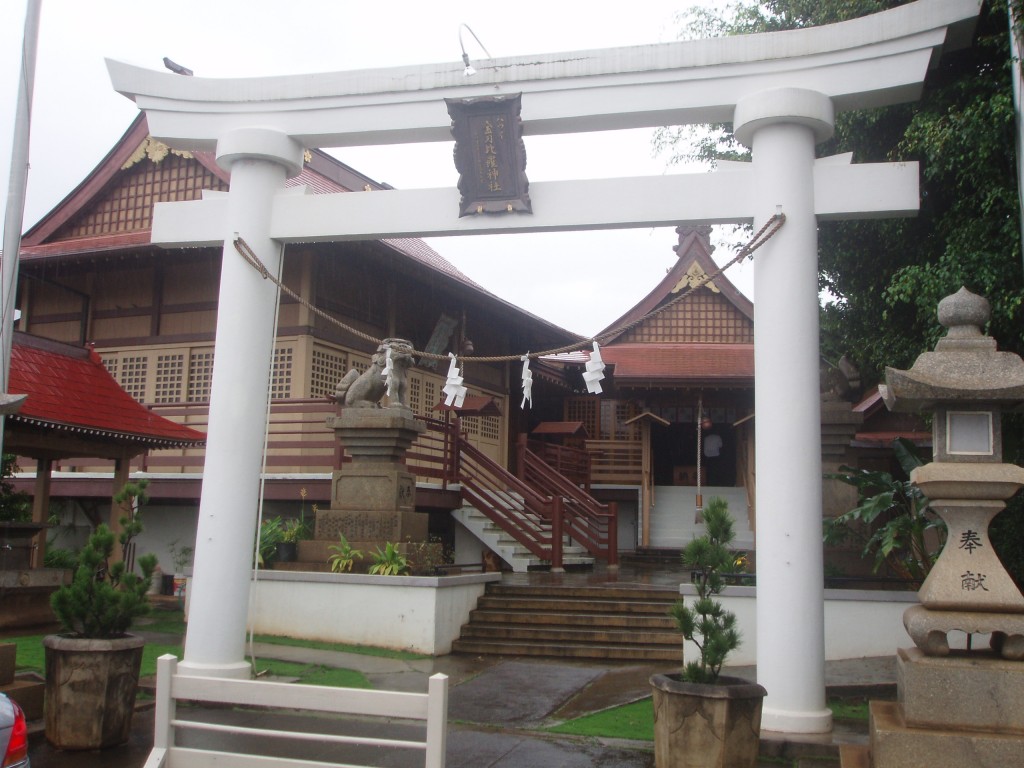
Hawaii Kotohira Shrine
In 2005 I went on a trip to Hawaii and visited six different Shinto shrines there – Kotohira, Izumo Taisha, Ishizuchi and Daijingu in Honolulu, plus Hilo Shrine on Hawaii island and one on Maui. At the time information was hard to come by, and I thought that I had visited all of the Hawaii shrines, but checking on the internet just now I see Wikipedia has a listing of seven shrines in Hawaii, the extra one being Ma’alaea Ebisu Jinsha about which I know nothing.
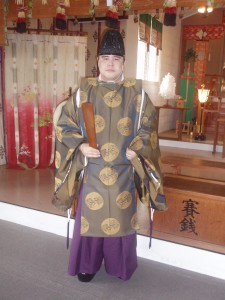
Rev Watanabe at the Hilo Shrine
My interest lay in how Shinto fares outside its home base of Japan, and to what extent it catered for non-Japanese. In this respect I had talks with Rev Okada of Izumo Taisha and Rev Watanabe of Hilo, and I also attended a morning ritual at Ishizuchi Jinja. I’d read reports of how in contrast to Buddhism, Shinto was prone to fade outside Japan as emigrants lose their culture and become assimilated. The religion originated after all in communality and ties to the land.
There were several surprises, such as the church-like pews at Hilo and the bilingual golf omamori (amulet) at Kotohira Shrine. But the biggest surprise was that George Washington had been enshrined as a kami. This seemed a huge leap in terms of Shinto, with enormous implications for how the religion could spread beyond Japan. Though I was eager to learn more, I couldn’t find out very much about it.
Later I got in touch with Paul Gabriel Gomes, an MA student working on a dissertation about Shinto in Hawaii, who told me that both George Washington and Kamehameha the First were enshrined in 1921 by Rev Kawasaki (according to an undergraduate paper done right before the war in June 1941).
Paul wrote to me as follows: “From my interview with Rev. Okada (at Izumo), it seems that Rev. Kawasaki was a very progressive thinker for his time and profession. There doesn’t seem to be much evidence that the central Ise authority tried to impose much guidelines on the shrines in Hawaii. Also it seems like something that non-exclusivist religions tend to do here. The Daoist shrine in Chinatown has a small area where “akua” (local Hawaiian gods) are kept.”
Apart from the kami at Hawaii Izumo, the other evidence of indigenisation was at Kotohira Shrine (full name, the Hawaii Kotohira Shrine-Hawaii Tenmangu Shrine). The priest there Rev Takizawa is apparently very active, though he was away in Japan when I called. It seemed the most flourishing of the shrines I visited, and I gathered that many non-Japanese participate in festivals and events such as the New Year celebrations.
The American orientation of the shrine was conspicuous, with Stars and Stripes on display, and to my amazement there was an amulet called ‘Spirit of America Omamori’, the sign for which said ‘Show your American spirit and resolve with our exclusive patriotic omamori.’ Shinto is often described as a religion of Japaneseness, so it was striking to see it being used to promote American patriotism. It could be said to provide a model of how Shinto can make the leap to a different culture, though Green Shinto would advocate a different path which is based on the spirit of universalism.
At Maui, there was a different picture of how Shinto had fared in Hawaii, for the impressive shrine buildings were in a bad state of repair. I gathered there was an elderly female priest, who was unable to function very well, and that it was more or less unused. I read later that the building was being considered for conservation (see here).
From his research Paul Gabriel Gomes was able to summarise for me the overall situation in Hawaii as follows:
“Shinto is relatively miniscule outside of Japan when compared to Japanese Buddhism, and many think it’s a declining religion of elderly here. I’m finding that it’s almost amazing that Shinto persisted after WWII considering both the governmental pressure and the grass-roots social pressure exerted on it.
Japanese Buddhism took up some of the functions of Shinto here in Hawaii, and there was heavy organized pressure from Christian missionaries. It seems Shinto was a small second partner to Buddhism here even before the war.
The Shinto groups that persisted here seems to be linked with a singular charismatic authority that held the community together. Shinto practice in Hawaii is much more reminiscent of practice in Japan than Japanese Buddhism in Hawaii is of Buddhism in Japan. Shinto is melded into the larger social fabric of Hawaii in ways which skirt the borders of secular and religious, esp. with Shichigosan and New Year’s.
Maui Jinja might already be non-operative and I know that Ishizuchi Jinja is down to a handful of members. However, while the priests I’ve interviewed say there is decline in general, the non-Japanese elements of the population visiting at New Year’s, requesting services and becoming members is up, though nowhere near the amount necessary to make up for deaths and secularization.”
*********************************************************************
For a report on Shinto in Hawaii from 1984 by a professor of religion, see here. For a symposium on Shinto and internationalisation, which includes a report on the Hawaiian situation, see David Chart’s blog here.
**********************************************************************
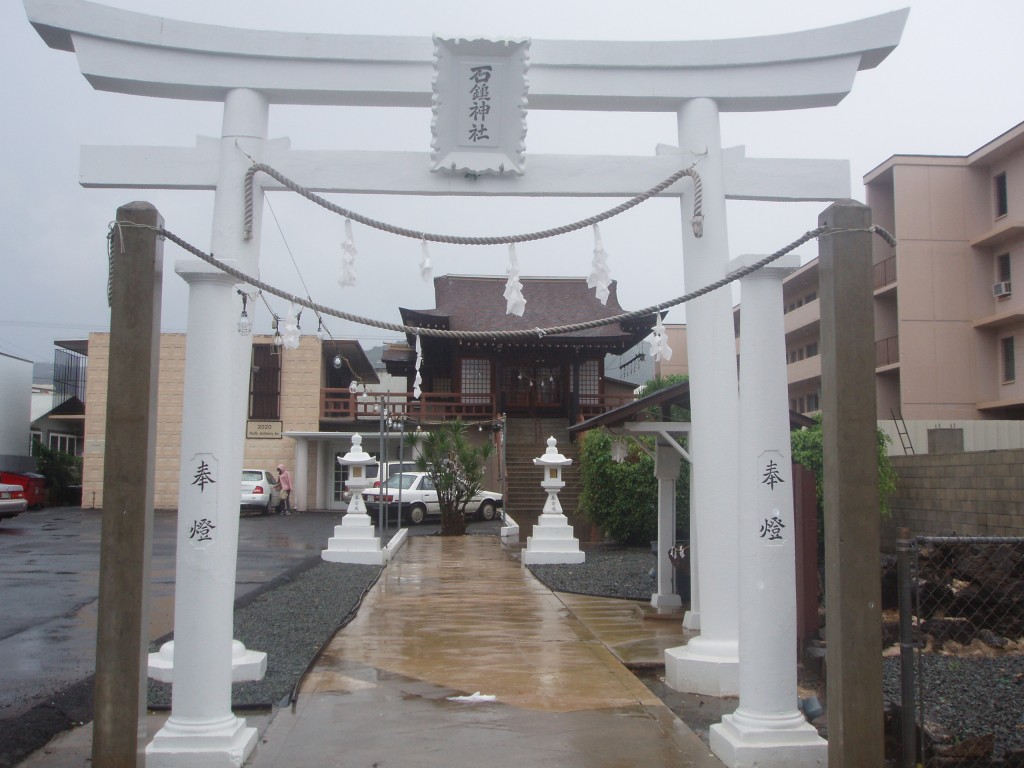
Ishizuchi Shrine – a touch of Greek about the pillars between the two sets of torii?
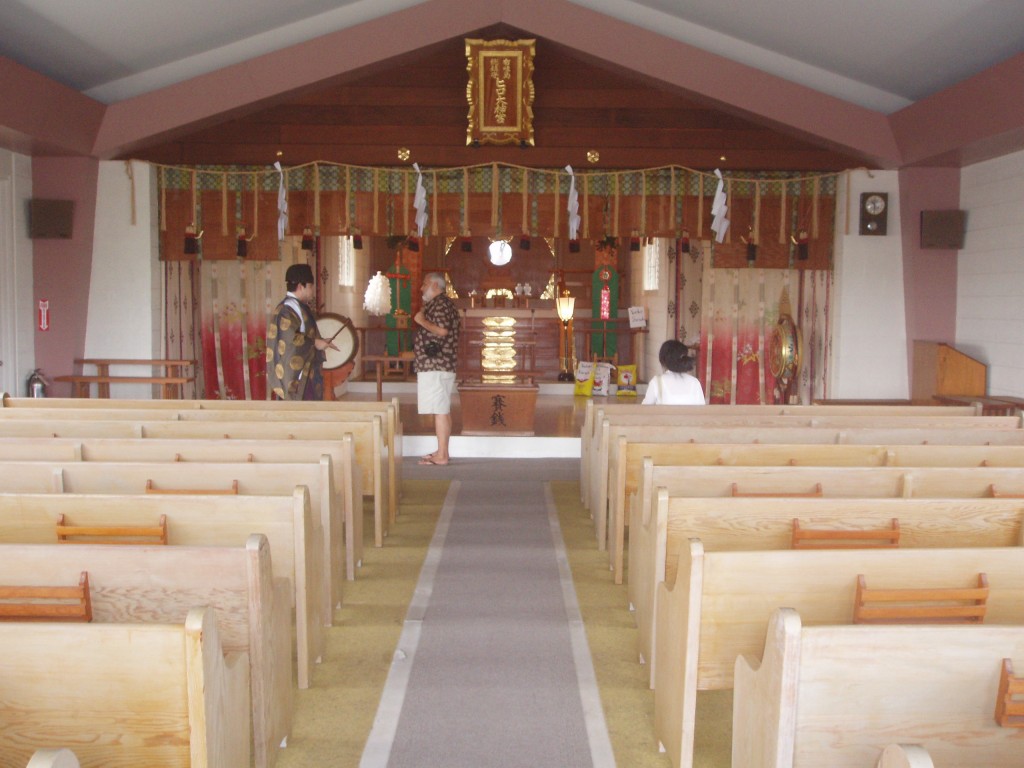
Adaptation – Hilo Shrine with what looks very much like church pews

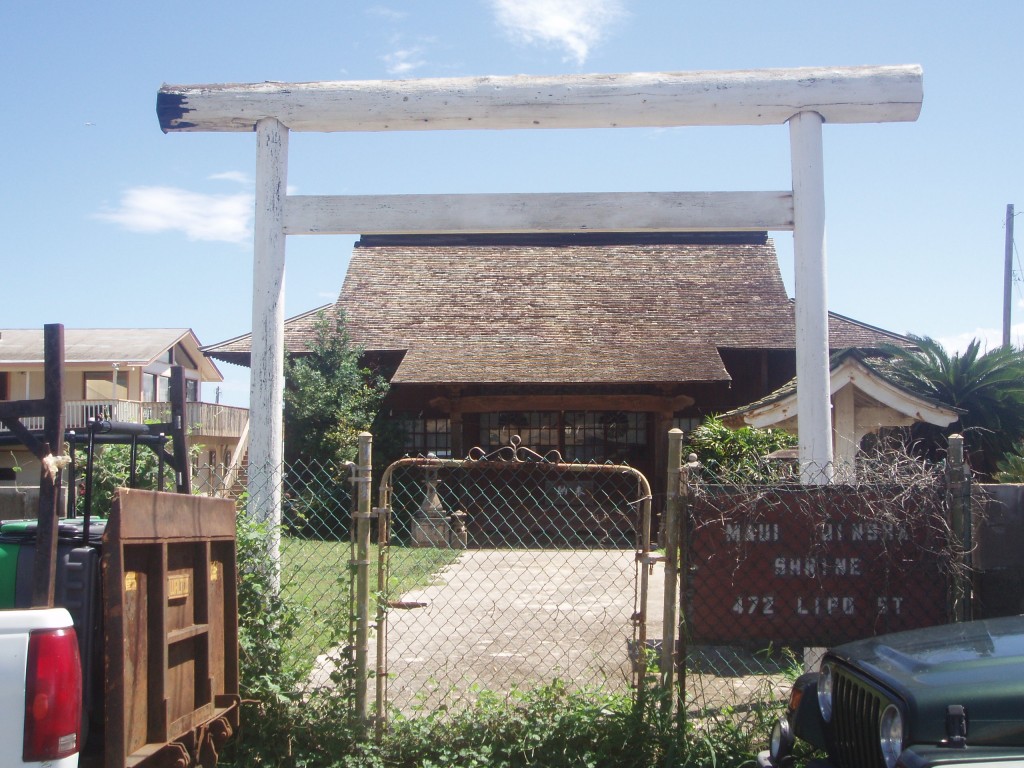
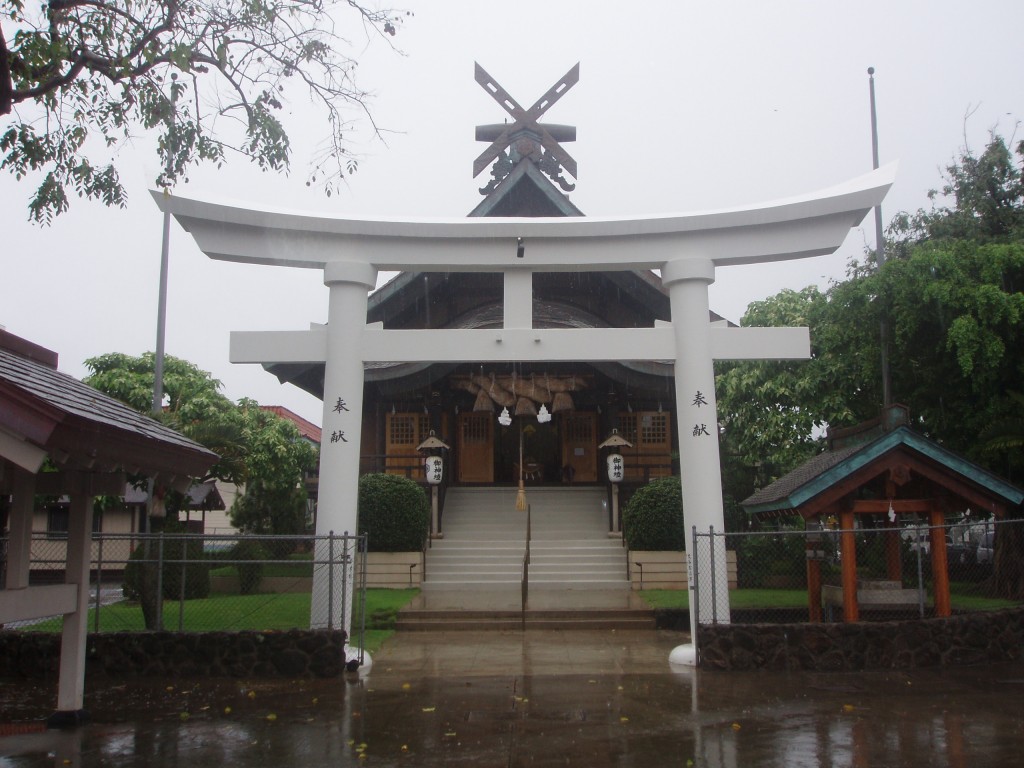
I am living in Japan, and have recently become much more interested in Shinto. This website has become a regular stop for me.
I am curious, when you write “…though Green Shinto would advocate a different path…”, do you mean “Green Shinto” in the same way as a newspaper editorial might say “…the editors would advocate…”? Or is there a practice of Shinto known as Green Shinto, with specific tenets? If so, I’m very interested to know more.
Thank you for your interest, Quin, and that’s a good question. Basically it’s written, as you suggest, in the form of a newspaper editorial. However, it’s also hoped one day in the future that there will be a form of universal, environmental Shinto. I believe the seeds cast today will inevitably bear fruit in the future as the environmental crisis worsens.
I also am hopeful that the overall direction of Shinto will continue in the green direction. Thanks for your response, and I’ll keep on reading with interest.
Although the original post is almost three years old – I would like to correct a few errors: King Kamehameha (who united the Hawaiian Islands) and President George Washington were enshrined at the Daijingu Temple of Hawaii by Reverend Kawasaki, not at Izumo Taisha. Reverend Akihiro Okada is the current priest at the Hawaii Daijingu and was never at Izumo Taisha. The name of the current priest at Kotohira is Reverend Masa Takizawa and not Takizaka. Since there are very few sources of information about Shinto in Hawaii, accurate information is important and appreciated.
There are five Shinto shrines on the island of Oahu: Daijingu Temple of Hawaii, Kotohira Jinsha, Izumo Taisha, Ishizuchi Jinja, and Wakamiya Inari. Two on Maui: Maui Jinsha and Ma’alaea Ebisu Kotohira, and one in Hilo on the island of Hawaii.
The priestess at Maui Jinsha, Reverend Torako Arine, passed away in 2014 at the age of 100. Reverend Okada went to Maui in January 2016 to do the sagicho of the omamori returned to the shrine at New Year. I’m not sure who is maintaining the shrine.
Daijingu’s Autumn Matsuri will be held on September 11th, Kotohira’s on September 25th and Izumo Taisha’s on October 9th. Ishizuchi’s is not a public event. Wakamiya Inari is in the Hawaii Plantation Village Cultural Garden and although it has a goshintai, it does not have a priest and is maintained by community volunteers.
Daijingu, Kotohira and Izumo have services at the start of each month that are open to the public and draw huge crowds for hatsumode. Although there are many people in Hawaii who go to the shrines to be purified at the start of the year and to pick up omamori, there is a general lack of understanding of Shinto. The members of the Japanese Cultural Center’s Cherry Blossom court had to be taught how to nirei-nihakushu-ichirei.
With each generation the meaning of Shinto ceremonies, beliefs, and ceremonial practices are lost. I recently helped a martial arts dojo hold a kagami biraki ceremony for the first time and I hope that those in attendance share the experience with others.
Thank you very much for the information. I’m presuming that’s Irene Takizawa? I’m not sure how the very bizarre Izumo Taisha crept into the text but there are gremlins everywhere it seems… I did of course know that George Washington and King Kamehameha were enshrined at Daijingu since I personally visited the shrine on my trip to Hawaii. I also briefly met you. I must say I’m sorry to hear of the demise of Rev Arine, though I gathered that the shrine had not been operative for some time. But it’s very good to have information about the events to be held at other shrines. Thank you for taking the trouble to write in, and I hope that any readers in Hawaii will be able to take advantage of the opportunity.
Aloha. No, this isn’t Irene although I do know her from Kotohira. I’m just a sansei trying to get back in touch with something my grand parents understood but did not pass on to my generation,
.
Aloha… I see. Good luck with your quest. It’s often said that while Buddhism travels quite well, Shinto has had trouble with the Japanese diaspora, being transmitted with the first generation but fading by the third generation as the grandchildren become integrated into the host community. In terms of identity, I can see it must be appealing to get back in touch…